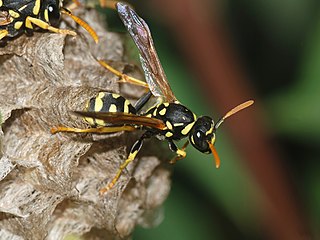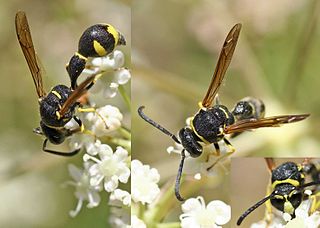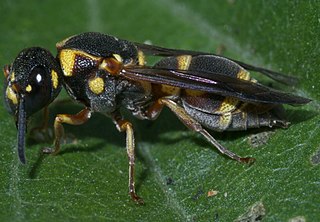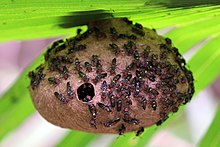
Polistes is a cosmopolitan genus of paper wasps and the only genus in the tribe Polistini. Vernacular names for the genus include umbrella wasps, coined by Walter Ebeling in 1975 to distinguish it from other types of paper wasp, in reference to the form of their nests, and umbrella paper wasps. Polistes is the single largest genus within the family Vespidae, with over 200 recognized species. Their innate preferences for nest-building sites leads them to commonly build nests on human habitation, where they can be very unwelcome; although generally not aggressive, they can be provoked into defending their nests. All species are predatory, and they may consume large numbers of caterpillars, in which respect they are generally considered beneficial.

Eumenes is a genus of wasps in the subfamily Eumeninae. It is a large and widespread genus, with over 100 species and subspecies occurring worldwide. The genus was first proposed by Pierre André Latreille in 1802, with the type species later designated by Latreille in 1810. All species make jug-like nests out of mud, usually attached to twigs. The larvae are fed with caterpillars.

Apoica is a genus of eusocial paper wasp found throughout the Central and South American tropics. These wasps are truly nocturnal, carrying out their foraging activities after the setting of the sun. They prefer to construct their nests, which have an open comb like many paper wasps, under large leaves, or in shrubs. During the day, wasps covering the comb fan their wings to cool the nest, keeping it at a suitable temperature for larval development.

Monobia is a primarily neotropical genus of medium-sized to large potter wasps occurring from the United States to Argentina. This genus is very closely related to the genus Montezumia. It contains the following species:

Mischocyttarus is a very large, primarily Neotropical genus of social wasps with a few species found also in the Nearctic region. It is the only member of the tribe Mischocyttarini; the asymmetrical tarsal lobes of Mischocyttarus separates it from the tribe Epiponini. Mischocyttarus is the largest genus of social wasps, containing over 200 species and subspecies. Mischocyttarus wasps build a relatively simple, single comb nest. Sometimes, the nest is built within a meter of the nest of Polistes carnifex. Foraging adults bring nectar and small caterpillars back to the nest to feed to the developing larvae which are individually housed in separate cells in the nest. Not all nests have a female with developed ovaries. Their biology is similar to that of species in the genus Polistes. However, Mischocyttarus appear to show considerably more social and reproductive flexibility than Polistes.

Anterhynchium is an Afrotropical, Indomalayan, Australian and Palearctic genus of potter wasps. As in many species of wasp, female wasps defend against predation using a modified ovipositor to sting predators. Like some other wasps in the Vespidae family, male wasps can produce a "pseudo-sting" with two sharp spines on either side of their genitals; however, unlike in the females, this "sting" is venomless.

Synagris is an Afrotropical genus of large potter wasps. Several Synagris wasps are strongly sexually dimorphic and males bear notable morphological secondary sexual traits including metasomal lamellar or angular protruding structures and hornlike or tusklike mandibular and/or clypeal projections.

Delta is an Old World genus of potter wasps with species predominantly distributed through tropical Africa and Asia. Some species are present in the Palearctic region, and a few have been introduced in the Nearctic and Neotropical regions. The members of this genus have a long metasomal petiole, like members of the genera Eumenes and Zeta.
Hypodynerus is a South American, primarily Andean, genus of potter wasps with most of its described species inhabiting Chile. The species included in Hypodynerus include:
Cyrtolabulus is an African, Indomalayan and Palearctic genus of potter wasps. It contains the following species:

Ropalidia is a large genus of eusocial paper wasps (Polistinae) in the tribe Ropalidiini distributed throughout the Afrotropical, Indomalayan and Australasian biogeographical regions. The genus Ropalidia is unusual because it contains both independent and swarm-founding species. Ropalidia romandi is one of the swarm founding species, meaning that new nests are founded by a large group of workers with a smaller number of inseminated females, while Ropalidia revolutionalis is independent-founding, meaning that each nest is founded by a single foundress.
Subancistrocerus is an Australian, Indomalayan, African and Palearctic genus of potter wasps. Males of this genus used to have an enlarged antennal tip.

Stenodynerus is a rather large genus of potter wasps whose distribution spans the Nearctic, Palearctic, Oriental and Neotropical regions. Most of its species lack a transverse carina on the first metasomal tergum. A pair of medial pits on the anterior face of the pronotum and the expansion of the tegulae put this genus close to genera as Parancistrocerus, Hypancistrocerus and Eustenancistrocerus.
Knemodynerus is a genus of potter wasps distributed through the Palearctic, Afrotropical, Indomalayan and Australasian regions. The species currently classified in the genus are:

Rhynchium is an Australian, Afrotropical, Indomalayan and Palearctic genus of potter wasps.

Belonogaster is a large genus of mainly Afrotropical quasisocial wasps, although some species occur in Arabia and two extend as far as India. They have characteristics of both the eusocial and the solitary wasps. Belonogaster constructs communal paper nests where the grubs are fed on masticated, soft-bodied insects such as caterpillars. The type species is Belonogaster juncea, which consists of two subspecies: Belonogaster juncea colonialis and Belonogaster juncea juncea. Belanogaster wasps are an important food source for wintering European honey buzzards in sub-Saharan Africa. In African traditional medicine, wasps of the genus are cooked with plant roots and consumed to cure various childhood sicknesses, as well as having ceremonial use similar to that of honey bees. Some birds choose to build their nests near the nests of Belonogaster for protection, including mousebirds and weavers.

Chrysis is a very large genus of cuckoo wasps. It is the largest genus in the family, including over 1,000 species in over 20 subgenera, as speciose as all remaining Chrysididae combined. The generic name is derived from Greek chrysis, "gold vessel, gold-embroidered dress", and pays tribute to the brilliant metallic appearance of wasps in the genus.
Labus is an Indomalayan genus of potter wasps. It contains the following species:

Delta emarginatum is a species of potter wasp in the subfamily Eumeninae of the family Vespidae.
















